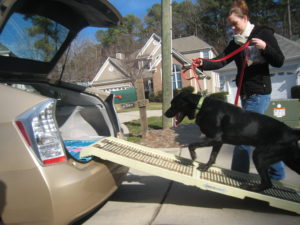Mobility Tips and Tricks for Senior Dogs
March 18, 2021 - 15 minutes readWhether it be an old Great Dane who has trouble getting up on a slippery floor or a graying Chihuahua who finds it difficult to jump up on the bed, many of our aging pups struggle with mobility. Decreased mobility can be a huge factor in decreased quality of life for our senior dogs. The tips and tricks in this blog post are meant to give you several tools to support and aid your elderly dog’s mobility. This isn’t an exhaustive overview of the topic. As always, we also strongly encourage you to have a conversation with your primary care veterinarian to discuss the most comprehensive way to help your sweet, older pup navigate the world safely and securely.
My dog has a lot of trouble getting up and walking on hardwood or tile floors. What can be done to help her?
Avoid the area: Many of us have flooring in our house other than carpet. Whether it be all throughout the house or only in certain locations, these slippery floors are often challenging areas for older dogs to navigate. One simple but sometimes difficult to implement suggestion is to limit your older dog’s access to these areas of the house. If they only need to venture into these locations occasionally, then you can be present to help them navigate the area safely. If that is not possible, then the remaining tips may be helpful for you and your pup.
Slow it down a bit: As with people, some older dogs don’t seem to accept that they are older and at higher risk of injury. Older pups who have trouble on slippery floors are more likely to injure themselves if they are permitted to run, jump, or roughhouse on those surfaces. Discouraging these activities on slippery floors (and even non-slippery floors for dogs with significant mobility challenges) may help to keep older dogs safer.
Improve their traction with area rugs: Often one of the first tips for older dogs on slippery floors is to boost their traction by utilizing area rugs or entryway mats with gripping material either on the back or on the front and back. These are best placed in all of the areas where your dog most commonly lays down or sleeps as well as in high traffic areas. Be present when your dog first uses these rugs or mats to ensure that they do not slip out or bunch up in such a way that they are ineffective or a tripping hazard.
Improve their traction by trimming nails: A simple (but not always easy) way to give an older dog more traction on slippery surfaces is to ensure that their toenails are kept short. Although this can be challenging, especially for dogs with dark toenails, this is essential for ensuring a dog can properly use their own paw pads for traction. If you struggle to trim your dog’s nails on your own, contact your primary veterinarian and ask about options to enlist their help in this task.
If a dog’s nails are overgrown, it is important to realize that to get them back to their proper length without trimming the quick (blood vessel and nerve in the nail), frequent (every 1-2 week) and minimal (just the nail tip) trimming may be necessary for several months. Once your dog’s nails are at the proper length, then routine trimming (every 3-4 weeks) is recommended to maintain that optimal length.
Improve their traction with toe or paw pad grips: Along the lines of dog nails, another potentially helpful tool would be products that go around the nails or stick to the paw pads to provide extra gripping traction to the nails or paw pads. Be careful using these products if your dog is a chewer or enjoys eating things that they shouldn’t. For both types of products that go on the toenails or the paw pads, be sure to follow the instructions for preparing the nails and/or paw pads before application. Carefully review and investigate these products before use to determine if they are likely to meet your dog’s needs.
Improve their traction with gripping booties: Another option for providing extra traction to your older dog’s feet is to use rubber gripping doggie booties or socks. These can be found from various retailers, or if these commercial products don’t work or you’re more into DIY, then you can actually make such doggie booties yourself!
My family made my older pup doggie booties from toddler’s winter mittens that had rubber gripping on the palm and elastic at the cuff; another viable option would be toddler’s socks that also have rubber gripping on the bottom.
If you have trouble keeping these DIY booties cinched up on your dog’s legs or if they twist around on the paw such that the gripping portion is no longer underneath your dog’s paws, consider these two solutions:
#1: Sew a strip of knit fabric (such as an old cut up t-shirt) to the outside cuff of each mitten or opening of each sock and then tie the ends of the knit fabric together over your dog’s back around their shoulder blades. You’re essentially making ‘suspenders’ for the mittens or socks to keep them up on your dog’s legs. Theoretically, you could try this for the back legs as well but I never have and it may be more difficult to get the tied-together fabric ends to stay up around their hips.
#2: Get two pairs of toddler’s mittens or socks, cut them apart to separate the gripping bottom and non-gripping top and sew only the gripping bottoms together so that there will be gripping material on both the top and bottom. That way no matter if it flips around or not, your dog will still have gripping material under their paws. Given the natural contour of mittens vs. socks, this may work better with mittens; I’ve never tried it with socks.
My senior dog can no longer jump into the car or up on the couch. How can I help him?
Help them climb the ladder of success: If your older pup is having trouble or was advised by your veterinarian not to be jumping up onto furniture or into the car, often an easy first step is making or purchasing small sets of doggie stairs. There are many different sizes, shapes, and constructions that can be used for couches, beds, and even cars. Not every dog will intuitively know how to use these stairs so using positive reinforcement training techniques can help your dog learn this new skill.
When stairs become too difficult: While stairs can be quite helpful, there often comes a time when even a few stairs are difficult for an older, arthritic dog. In these scenarios, ramps may be the answer. Similar to stairs, these can be made or purchased for couches, beds, or cars. Be sure that whatever device you make or purchase has very good gripping material on the surface so your pup doesn’t simply slide down the ramp. Again, like stairs, not every dog will intuitively know how to use a ramp so using positive reinforcement training techniques can help to familiarize them with this new addition to their environment.
When simply getting up is difficult: Similar to when stairs become difficult, there often comes a time, especially for medium to large-breed dogs when getting up from a lying position is very difficult even when using the tips and tricks discussed above for improving their traction. In these cases, using a support or mobility harness may make a big difference. These products allow you as an owner to more easily assist your elderly dog with mobility challenges.
There are some products that are temporary lifting and/or walking aids that only support the hind end of a dog. These are generally easy to put on and take off but not intended for constant use.
Then there are other products that are meant to be a permanent or semi-permanent lifting and/or walking aid that can be used to support the front and/or hind end of a dog. These generally come in two separate pieces that can be linked together and they secure around the dog’s front legs/chest and back legs. These harnesses take a little more effort to put on but can be left on the dog constantly.
If you are considering purchasing a support or mobility harness, we recommend contacting your veterinarian to determine the optimal product, style, and size for your dog.
When getting up is no longer an option: Eventually, some elderly dogs are no longer able to walk on their own at all or for any reasonable length of time even with assistance. In these cases, if you still want them to enjoy the great outdoors or even simply want to more easily move them around the house, dog strollers or wagons can be used. Be sure that your dog is properly secured and cannot easily climb out or fall out. Also ensure that they are placed on thick padded cushions/pillows to avoid pressure sores and help them sit up and be comfortable while they are in the stroller or wagon.
We hope that these tips and tricks are helpful for any of you who are caring for senior dogs with mobility struggles. Again, be sure to carefully review and investigate any product that you elect to purchase before using it on your dog, and please contact your primary veterinarian for more specific recommendations for your particular pup.
 Whether your dog is young or old, regular veterinary wellness visits are vitally important for canine health. Early detection and diagnosis of a wide variety of health conditions can improve prognosis and slow the progression of disease. Age-specific preventive care suggestions can help dogs live longer, healthier lives, a goal that veterinarians like me, whether in private practice or at the Dog Aging Project, strive toward every single day. Working together with dedicated and loving owners such as all of our Dog Aging Project participants, we really can have a huge, positive impact on the quality of life for all dogs, young and old!
Whether your dog is young or old, regular veterinary wellness visits are vitally important for canine health. Early detection and diagnosis of a wide variety of health conditions can improve prognosis and slow the progression of disease. Age-specific preventive care suggestions can help dogs live longer, healthier lives, a goal that veterinarians like me, whether in private practice or at the Dog Aging Project, strive toward every single day. Working together with dedicated and loving owners such as all of our Dog Aging Project participants, we really can have a huge, positive impact on the quality of life for all dogs, young and old!

Kellyn McNulty, DVM
Research Team
Feature photo by Russell Harrison
